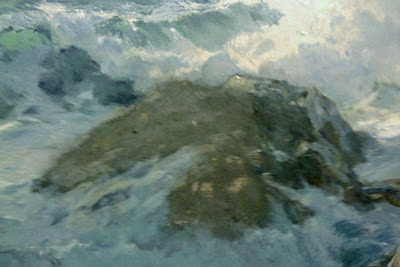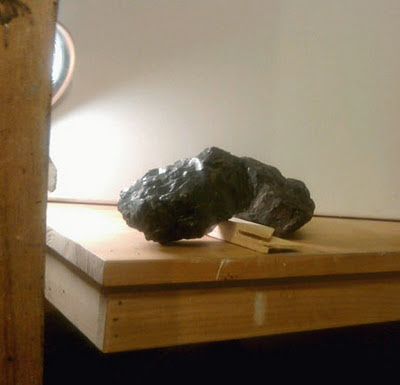Sisyphus, by Titian
 As those of you who read my blog already know, I fight like hell to get my paintings to work. The more you learn about painting, the harder it gets. Eventually it will become too hard for me to do at all.
As those of you who read my blog already know, I fight like hell to get my paintings to work. The more you learn about painting, the harder it gets. Eventually it will become too hard for me to do at all.IT ONLY MATTERS WHAT THE PAINTING ACTUALLY LOOKS LIKE, NOT HOW LONG IT TOOK OR HOW HARD YOU HAD TO WORK TO MAKE IT!
Sometimes a passage (or area) of a painting just doesn't work. Here is one of those. Its time to give this One a second chance! This is a group of rocks in the middle of a seascape. After struggling for days with it, finally I decided to rip the whole thing out and have another go at it. It was time for a fresh start. Because I worked a long time trying to get these rocks right, I built up a lot more paint than I wanted. Above is the failed passage, that has been sand papered down. I wanted to get the surface back to flat and level so I could start over and not have pentimenti (ridges from the previous brushstrokes) visible under my newly applied paint.
First I scraped the surface with the side of my offset, leaf shaped palette knife to get as much of the paint off as I could. Then I sanded it until it was flat with 80 grit sandpaper. I wet sanded it by dipping my sandpaper in mineral spirits. Then I finished it off with the 150 (sand paper with a higher number is finer). I think I get better results wet sanding, but also I don't want all the dust from my pigments flying up into the air for me to breathe, if I wet sand the painting that doesn't happen. I wear nitrile gloves when I paint so I didn't get the resultant toxic slurry all over my hands and abdomen.
 I had been trying to just " invent" the rocks, something I am sometimes able to do. It wasn't working for me this time so I needed to hire a model. Above is my "model". Those are two pieces of anthracite coal picked up from an old railroad bed in Vermont. I have a box of about twenty of these and I use them for just this purpose. I have sprayed them with krylon to give them a little more reflective surface. Anthracite coal looks a lot like ocean rocks, it has facets and unusual shapes. I can look at it and use those shapes to create rocks in a seascape that don't look too "man made". It is necessary to simplify them or only use some parts of them, but it really helps to imagine the forms and the different planes turning against the light.
I had been trying to just " invent" the rocks, something I am sometimes able to do. It wasn't working for me this time so I needed to hire a model. Above is my "model". Those are two pieces of anthracite coal picked up from an old railroad bed in Vermont. I have a box of about twenty of these and I use them for just this purpose. I have sprayed them with krylon to give them a little more reflective surface. Anthracite coal looks a lot like ocean rocks, it has facets and unusual shapes. I can look at it and use those shapes to create rocks in a seascape that don't look too "man made". It is necessary to simplify them or only use some parts of them, but it really helps to imagine the forms and the different planes turning against the light.I have a clamp light with a 40 watt "daylight colored" bulb in it at the same angle I want my light to be hitting the rocks that I intend to paint. This little tableau is on a wooden shelf cantilevered out from the wall right next to my easel at just below my eye level ( I am 32 feet tall, and weigh over 1600 pounds).
Below are the rocks, redux. I have elongated the rock on the left, I needed it to fit into a particular area of the painting. I have also thrown some color in there, sometimes the coal looks great painted it's actual color, but in this case I wanted a red-orange Cape Ann granite.

Perhaps if I ever get this painting finished I will post it so you can see how it comes out. I still have a fair amount of refinement to do on this area, but you can see what I am up to.
-----------------------------------------------------------------------------------------------
There is still room in Snowcamp. The first session is filled but the second still has a few spaces. If you would like to come you can sign up here. Snowcamp happens at a big old wooden inn high on a ridge in the White Mountains of New Hampshire. The inn overlooks the Cannon Mountain and the Presidential range. We paint outside just out the back door of the inn so if you get cold you can run inside and warm up by the fire. The Sunset Hill Inn takes good care of us and everything we need is right there. I park my car and forget it while I am there. Snowcamp is a three day total immersion experience that runs from breakfast until well after dinner. It is a great way to meet other painters and learn how to work outside in the winter. Snow painting is my favorite thing, and I will show you some of the tricks I have picked up in my about 30 years of painting it.












